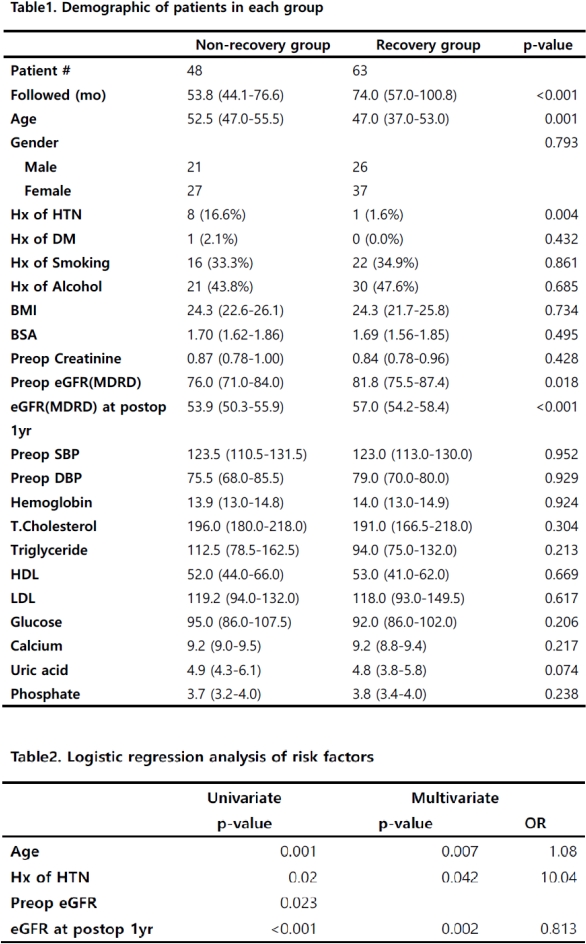Long-Term Follow Up of Living Kidney Donors with CKD at 1 Year after Nephrectomy
1Department of Urology, Yonsei University College of Medicine, Urological Science Institute, Seoul, Korea
2Department of Urology, National Health Insurance Service Ilsan Hospital, Goyang-si, Korea
3Department of Urology, Hanyang University Medical Center, Seoul, Korea
4Department of Surgery-Transplantation, Yonsei University College of Medicine, Seoul, Korea.
Meeting: 2018 American Transplant Congress
Abstract number: B164
Keywords: Donation, Kidney, Renal function
Session Information
Session Name: Poster Session B: Kidney Living Donor: Long Term Outcomes
Session Type: Poster Session
Date: Sunday, June 3, 2018
Session Time: 6:00pm-7:00pm
 Presentation Time: 6:00pm-7:00pm
Presentation Time: 6:00pm-7:00pm
Location: Hall 4EF
Introduction:Many kidney donors show poor recovery after donation and the long-term prognosis of those patients has not been well studied. In this study we explored the long-term prognosis of renal function in patients with CKD at 1 year after nephrectomy.
Method:Patients who underwent donor nephrectomy during March, 2006 to April, 2014 with a follow up creatinine study at the post-operative 1 year period and for more than 3 years of follow-up were included in the study. Creatinine, and estimated GFR(eGFR, MDRD) before and after surgery was studied. Age, sex, history of hypertension or diabetes, BMI, blood pressure, CBC, pre-operative routine serum chemistry and urine study results were reviewed.
Result: Among 841 patients who had donor nephrectomy, 362 patients were included in the study. 111 patients (30.6%) had eGFR lower than 60ml/min/1.73m2 at 1 year post-surgery, and the median follow-up period was 62.8 months(IQR:42.0-86.3). The maximum eGFR after 3 year follow-up was studied and 48 patients (43.2%) never recovered eGFR higher than 60ml/min/1.73m2. Age, history of hypertension, preoperative eGFR, eGFR at 1 year were predictive factors at univariate analysis. Multivariate analysis of these factors was studied and age(52.5(IQR:47-55.7) vs 47(IQR:7-53), p=0.007, OR 1.1), history of hypertension(16.7% vs 1.6%, p=0.042, OR 10.0), eGFR at 1 year(53.9(IQR:50.3-56.0) vs 57.0(IQR:54.2-58.4), p=0.002, OR 0.813) remained as significant risk factors.
Conclusion:Of all living donors, 15.7% were with CKD after more than 3years of follow-up. Close observation is warranted when donors are with CKD after 1 year follow-up as 43.2% fail to recover renal function. Patients who are older, with a history of hypertension, and with low eGFR at 1 year follow up are especially at risk.
CITATION INFORMATION: Na J., Park J., Yoon M-.G., Lee H., Yoon Y., Huh K., Kim M., Kim S., Kim Y., Han W. Long-Term Follow Up of Living Kidney Donors with CKD at 1 Year after Nephrectomy Am J Transplant. 2017;17 (suppl 3).
To cite this abstract in AMA style:
Na J, Park J, Yoon M-G, Lee H, Yoon Y, Huh K, Kim M, Kim S, Kim Y, Han W. Long-Term Follow Up of Living Kidney Donors with CKD at 1 Year after Nephrectomy [abstract]. https://atcmeetingabstracts.com/abstract/long-term-follow-up-of-living-kidney-donors-with-ckd-at-1-year-after-nephrectomy/. Accessed December 15, 2025.« Back to 2018 American Transplant Congress

